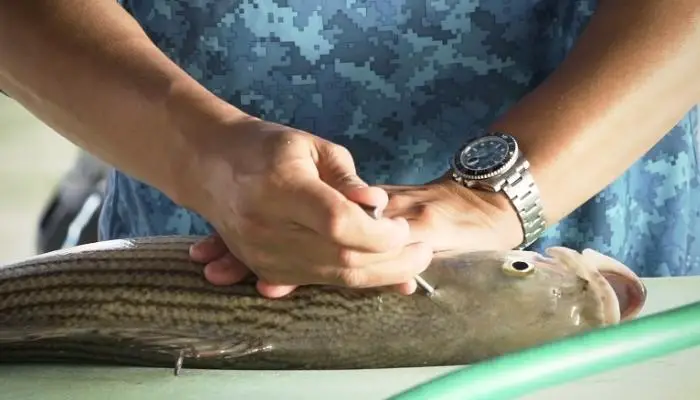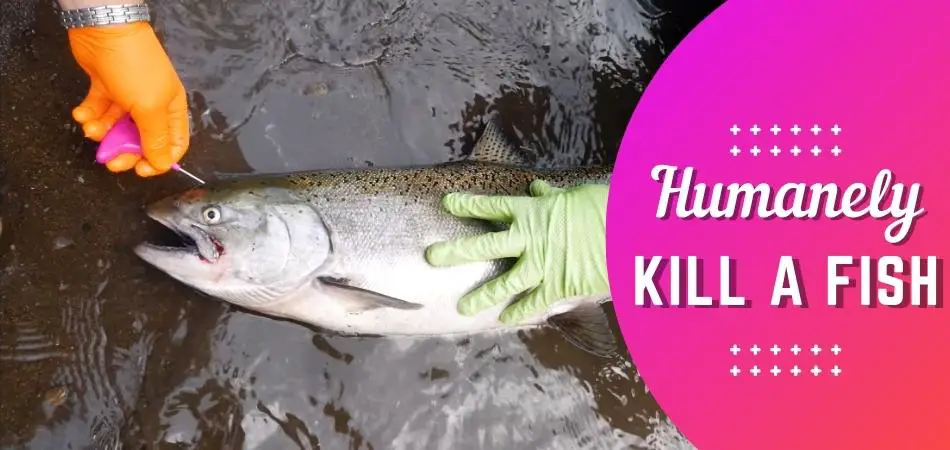How do you humanely kill a fish before cleaning it? This is a question that many people have, and the answer can vary depending on who you ask. Some people advocate for stunning the fish before killing it, while others say that it is unnecessary.
Most people who keep fish as pets will eventually have to kill and clean the fish. There are a few humane ways to do this, but the most common is by severing the spinal cord.
In this blog post, we will explore different methods of killing fish, as well as discuss the pros and cons of each method. Stay tuned to learn more!
What Is Humanely Killing A Fish Means?
Humanely killing a fish means making sure that the fish is unconscious and insensible to pain before it is killed. There are many ways to do this, but the most common method is to use a sharp knife to sever the fish’s spinal cord.

Other methods include using a blunt instrument to crush the fish’s skull or using an electrical current to stun the fish. Whichever method is used, it is important to make sure that the fish is dead before beginning any process of cleaning or cooking it.
What Are The Best Ways To Kill A Fish Humanely Before Cleaning It?
One of the most common methods is to use a sharp knife to sever the spinal cord at the base of the fish’s skull. This will quickly kill the fish and prevent it from feeling any pain. Another option is to place the fish in a bag of ice water. The cold temperature will cause the fish to go into shock and die quickly.
There are also some chemical methods that can be used to kill fish humanely. These include using a solution of salt and water or injecting the fish with a fatal dose of anesthesia. Whichever method you choose, it is important to make sure that the fish is dead before you start cleaning it. This will ensure that the fish does not feel any pain during the process.
How Can You Ensure That The Fish Doesn’t Feel Any Pain When You Kill It?
One way to ensure that the fish doesn’t feel any pain when you kill it is to stun it before killing it. This can be done by using a sharp blow to the head with a blunt instrument. Another way to ensure that the fish doesn’t feel any pain when you kill it is to cut its spinal cord. This can be done by slicing through the back of the fish’s neck with a sharp knife.
What Are Some of The Most Humane Methods for Killing a Fish?
When it comes to killing a fish, there are a few different options available. Some methods are more humane than others, and it really depends on your personal preferences as to which one you choose.

One popular method is using a small knife or sharp object to quickly kill the fish. This method is considered to be relatively humane, as it results in a quick and painless death for the fish. However, some people may not feel comfortable with this method, as it can be seen as cruel.
Another option is to use an electric stunner. This device stuns the fish, which then renders it unconscious. The fish can then be killed quickly and humanely with a sharp knife. This method is considered to be one of the most humane, as it ensures that the fish does not feel any pain or suffering.
Some people also choose to suffocate their fish by placing them in a plastic bag or container with no air. This can be done by either using a lid or by placing the fish in water. This method is considered to be humane, as it allows the fish to die slowly and without any pain.
Finally, some people choose to simply let their fish go free. This is often seen as the most humane option, as it ensures that the fish does not suffer in any way. However, this method is not always practical, and it is important to research your local laws before releasing a fish into the wild.
No matter which method you choose, it is important to be sure that you are comfortable with it. Killing a fish can be a difficult thing to do, so you want to be sure that you are doing it in the most humane way possible.
Which Method Do You Think Is the Best Way to Kill a Fish Humanely?
There are a few different methods that can be used to kill a fish humanely. The most important thing is to make sure that the fish suffers as little as possible.
One method is to stun the fish before killing it. This can be done by hitting the fish on the head with a blunt object, or by electric shock. Once the fish is stunned, it should be killed immediately by cutting its throat or decapitating it.
Another method is to asphyxiate the fish. This can be done by putting the fish into a container of water and adding a substance that will dissolve in the water and release carbon dioxide, such as dry ice. The fish will eventually die from a lack of oxygen.
Whichever method you choose, it is important to make sure that the fish is dead before you start to clean or cook it. The best way to do this is to check for signs of life, such as gill movement, and to use a sharp knife to cut through the spinal cord.
How to Properly Bleed and Clean the Fish?
First, it is important to understand how to properly bleed the fish. This will ensure that the fish is properly cleaned and will also help to prevent any potential disease. To bleed the fish, you will need a sharp knife. First, make a small cut near the base of the fish’s tail.
Then, insert the knife into the fish’s body cavity and make a long, deep cut along the length of the fish’s body. Next, use your fingers to pull the entrails out of the fish’s body cavity. Finally, rinse the fish off with clean water.
Once the fish has been bled, it is time to clean it. Start by removing the fish’s head. Then, use a sharp knife to remove the fish’s scales. Next, cut open the fish’s belly and remove the guts. Finally, rinse the fish off with clean water and pat it dry with a paper towel.
Now that you know how to properly bleed and clean the fish, you are ready to enjoy your catch!
Tips For Removing The Scales And Guts
If you’re cleaning a fish for the first time, it can be a bit daunting. But don’t worry, we’re here to help! Here are some tips for removing the scales and guts from your fish:
- Start by scaling the fish. You can do this by using a sharp knife or a fish scaler. Scaling the fish will make it easier to remove the guts later on.
- Once the fish is scaled, it’s time to gut it. Make a small incision in the belly of the fish and then gently remove the guts. Be careful not to puncture any of the organs, as this can make the dish taste bitter.
- Once the guts are removed, you can rinse the fish off with cold water. This will help to remove any blood or bacteria that may be on the surface of the fish.
- And that’s it! You’ve now cleaned a fish ready for cooking. Just remember to wash your hands thoroughly afterward.
We hope these tips have been helpful. Happy cleaning!
What To Do With The Head, Tail, And Bones
- Head: The head can be used to make a broth or soup.
- Tail: The tail can be used to make a stock.
- Bones: The bones can be used to make a bone broth.
How To Store The Cleaned Fish?
After you have thoroughly cleaned your fish, it is important to store them properly in order to keep them fresh. There are a few different methods that you can use to store your fish, depending on how long you plan on keeping them.
If you plan on eating the fish within a day or two, you can store them in the fridge. Place the fish in a plastic bag or container, and fill it with ice. This will keep the fish fresh for up to two days.
If you want to store the fish for a longer period of time, you can freeze them. To do this, wrap the fish tightly in plastic wrap or place them in a freezer bag. Squeeze out as much air as possible before sealing the bag. Fish will stay fresh in the freezer for up to six months.
Once you are ready to cook the fish, thaw them out in the fridge overnight or place them in a bowl of cold water. Do not thaw fish out at room temperature, as this can cause bacteria to grow.
Storing your fish properly will help to ensure that they are fresh and safe to eat. Use these tips to keep your fish fresh, no matter how long you plan on keeping them.
Final Thought
Clean fish with a sharp knife. Cut off the head and slice the body open from gills to the anus. Gut the fish by reaching in and pulling out the entrails, being careful not to puncture the stomach or intestines. Rinse everything under cold running water. Slice off the fins and tail at their attachment points on the body. Remove scales by scraping them off gently with a blunt knife or your fingers (optional).
